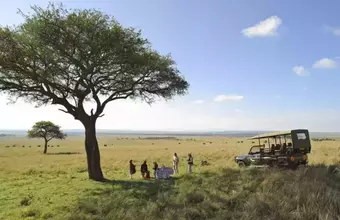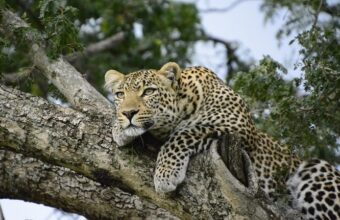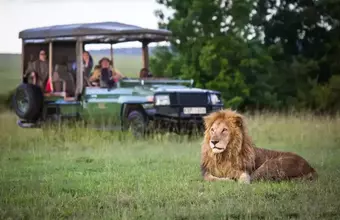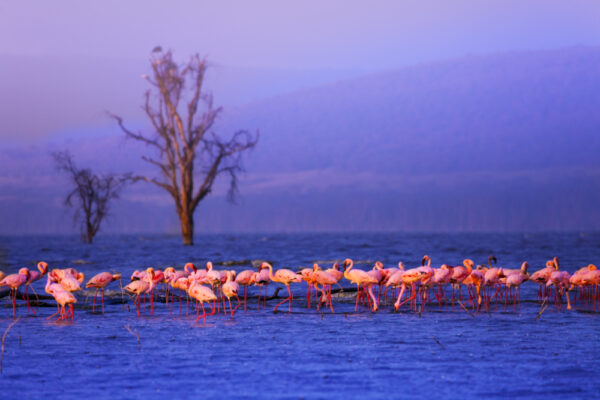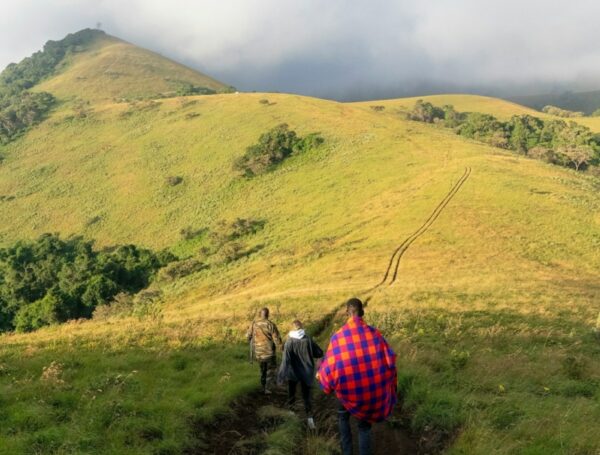Kenya safari costs
Typical prices for a safari in Kenya
Kenya safari costs: Quick reference
There are as many different ways of going on safari in Kenya as there are stripes on a zebra. The price of a Kenya safari can range from USD $150 to $1,000+ per person per day!
Budget safaris: from $150-$300 per person per day. You can find quick three-day safari tours from Nairobi for as little as $250, but I can't really recommend them.
Mid-range safaris: from $300-$600 per person per day in an all-inclusive tented camp.
Luxury & high-end safaris: from $600-$1,000+ per person per day! You’ll be glad that gin and tonic was included.
Typical costs for a Kenya safari
Safari prices and what you get for your money
Mid-range safaris
For a multi-day, mid-range safari visiting some of the big name parks and reserves then you’re looking at around USD $300-600 per person, per day.
This includes accommodation in a comfortable, if often uninspiring, safari lodge or camp, three reasonable meals a day, and game drives in a shared vehicle. This vehicle might be a good quality, open-sided jeep with just a couple of other guests, but equally it could be in an over-crowded minibus.
Depending on your itinerary transfers between national parks should also be included, although if internal flights are required these may be priced separately. It should also include park entry fees, which for the main parks is often around US$70 per person per day.
What to look out for
At this budget range you'll most likely be focused on the big name parks: the Mara, Amboseli, etc. These places get seriously busy during peak season. Try to find out where you'll be staying, and how far from other camps you'll be. Ask about the safari vehicles at each camp. Try to avoid tours that stay near the park main gates, although at this price your options may be limited.
High-end safaris
At the top end, you probably won't be staying within the more famous national parks themselves – it's more likely you'll be visiting the network of conservancies that fringe the more famous (and vastly busier) public reserves.
These are community or privately-run wildlife conservation areas that are run to the benefit of local communities and with wildlife conservation in mind.
A visit to one of these conservancies guarantees you one of the worlds finest safaris. The whole experience will be very exclusive with minimal other safari vehicles around. You will stay in luxury (but rarely brash or over-the-top) safari tents and enjoy world-class dining (with most alcoholic drinks included in the rates).
The price will include a superb wildlife guide and safaris in custom designed, open-sided vehicles. Your group will often have this vehicle all to themselves. The price also includes all conservation fees and any park entry fees.
So, how much are we talking? Well, at a minimum expect to pay USD $350 per person, per night at a quiet time of year. But, for the really superb places with the best guides and wildlife experiences it’s not at all uncommon to pay anything from USD $600-1,000 a night. At these prices you’ll be glad that gin and tonic was included in the price!
Now, before you instantly baulk at these prices you need to take time to understand what it is you’re paying for and why, if at all possible, you should strive for a top-end safari in a conservancy.
A conservancy is normally located on either communal land owned by the community as a whole or on private ranch land. On a community conservancy the tourism stakeholders (i.e. the safari camps) lease the land from the local communities on the condition that the land is managed in a manner that is of benefit to both people and wildlife. The fees you pay to stay on a conservancy go toward paying the land leasing fees as well as various community and environmental projects.
Meanwhile, conservancies on private ranch land have to make enough money for the landowner to financially justify turning his land over to wildlife conservation and tourism instead of cattle ranching. In other words, staying in a conservancy is not just a great safari experience but it’s also very good news for the local ecosystem.
What to look out for
You can't really go wrong in any of the conservancies or the camps and lodges you'll find there. If you have a particular activity in mind – for example, night drives, hot air ballooning, Maasai culture talks – just make sure they're available before you book.
The only other note of caution I'd offer is checking where the camp or lodge is headquartered. There are some excellent Kenyan, even community-owned, businesses, where more of your money will stay locally. Try to book with Kenyan-based businesses where possible.
Budget safari
Most of us want to save money where we can and spending hundreds of dollars a day to look at animals might seem a bit excessive.
For low cost budget safari, a quick-fix, three-day safari from Nariobi to the Masai Mara, Tsavo or Amboseli parks can be had for just USD $250 all in. For this price you’ll get transport from Nairobi, accommodation, meals and a couple of game drives. It might not include park entry fees (and the tour company may well forget to mention this).
Sounds great, but there’s a couple of very significant catches that should make you approach bargain offers like this with the utmost of caution.
What to look out for
Check how much time you'll actually spend on safari: most of these budget safaris are very rushed, and a three day point to point safari leaving and returning to Nairobi will only give you one day of game drives.
Ask about the vehicle quality: at this price level it's invariably battered old minibuses which are uncomfortable and offer poor or obstructed views.
How big is your group? If the minibus is full (and the safari company will likely do all it can to ensure that the vehicle is full), most passengers won't even have a window seat.
Will you have a proper guide? Some of the drivers used on these budget tours are knowledgeable and passionate about the parks and wildlife. Sadly though, some companies cut corners and use drivers who are matatu (public minibus) drivers in Nairobi and have little knowledge of the parks and wildlife. Worse, they may not know or respect park rules and regulations. It’s these guys who are mainly responsible for the horrible images you might have seen of forty or fifty vehicles tightly packed around one poor cheetah.
Where are you staying? Tis is not necessarily a bad thing, but the accommodation on a budget safari will be in small dome tents which are set up on public campsites with no facilities except a tap and a basic toilet block (and sometimes not even these). These safaris only ever take place in the main national parks and reserves and never in the conservancies (from which they are banned).
DIY or solo Kenya safaris
An ideal compromise between a budget safari and something more tailor made is a DIY safari.
Simply rent a quality 4WD jeep with a driver (it’s also possible to go it totally alone but for security and enjoyment reasons I'd recommend having a driver – it rarely adds much to the overall cost.)
Chuck a tent, camping gas stove and a pile of food in the back and off you go. You’ll be responsible for your own itinerary and (accommodation bookings aside) will be able to chop and change as you go. It will be far more comfortable than sitting in a minibus with a dozen other people and you can mix some nights of camping with nights in quality lodges.
Almost any tour company in Nairobi or Mombasa can organise a private vehicle with a driver and it should normally cost around USD $150-200 per day, including fuel and most driver expenses. You will cover your own accommodation costs, food, and park entry.
This is a particularly rewarding way for a family to travel. Note though that most conservancies will not allow you to enter in your own vehicle. If travelling this way and planning on spending time in a conservancy then conservancy camp staff will meet you at the entrance where you’ll transfer to one of their vehicles for the duration of your stay. Your driver will normally be given accommodation while he waits.
How to save money on a Kenya safari
You can cut costs by cutting corners: cheaper tours, lower quality camps, etc. But I really wouldn't recommend it – both for your own personal enjoyment and also for the impact on wildlife conservation.
But you can save a few dollars on your Kenya safari by being flexible in your chosen time of travel and where you go.
Low(er) cost seasons
High season (July-September & Christmas-February) will always cost the most, and low season (March-April & November) will of course cost the least.
The difference in price between the two periods can be as much as 50% for accommodation. So, it goes without saying that going on safari in the low (green) season saves you a lot of cash.
But, with far from optimum wildlife viewing at this time and many camps actually closed, I would instead suggest going on safari in mid season (late-May-June and October are superb). Prices are probably around 25% lower than high season but the wildlife viewing is often good and there are far fewer crowds.
read more
Where to find cheap(er) safaris
If you're fixed on seeing the "big five" then you’ve got little choice but to visit big name parks. But Kenya’s diversity of wildlife is incredibly rich and, sadly, many equally interesting animals get overlooked in the hunt for yet another lion photo.
If you’re willing to broaden your animal checklist a little and visit some of Kenya’s lesser known or smaller parks then not just will you get a more diverse picture of Kenya’s environments and wildlife but you’ll also save yourself a whole heap of cash because everything, from park entry fees to accommodation, is invariably a fraction of the price of the big name parks.
The west of Kenya is especially rich in such parks and reserves. Some of my favourite ‘off the beaten track’ (and much cheaper) parks include:
Kakamega Forest Reserve. Visiting this park out in the far west will allow you to walk through dense dark rainforest catching glimpses of elegant colobus monkeys and noisy hornbills.
Saiwa Swamp National Park, also in the west, has a raised wooden boardwalk that runs above a swamp where rare sitatunga antelope live.
Ruma National Park, also in the west, has towering roan antelope and one of Kenya’s healthiest (but elusive) rhino populations.
Hells Gate National Park in the Rift Valley, presents the opportunity to rent a bicycle and cycle over classic open savannah grasslands past herds of zebra.
The ideal would be to mix up a variety of lesser known parks with a couple of days in the big name parks.
Another way to save money is not to visit a national park or reserve at all. There’s plenty of wildlife living free outside of all the protected areas (some accounts say that 70% of Kenya’s wildlife lives outside of all official protection.
In the Loita Plains and hills area just to the north of the Masai Mara National Reserve there are a growing number of Maasai-run small, cheap camps and even home stays.
Spending a few days at one of these will give a great insight into Maasai life, help the local communities and allow you to watch herds of grazers at close hand as you just walk around.
Then we come to ‘urban’ national parks such as Nairobi and Nakuru National Parks. Both are impressive parks with a wide array of megafauna (rhinos are commonly seen in both parks). Although the ticket entry price is expensive, the fact that you can just hire a jeep or join a half-day tour from either Nairobi or Nakuru city centres and then return to sleep in the city means that you can get your wildlife thrills in a short space of time with minimal effort or expense.

